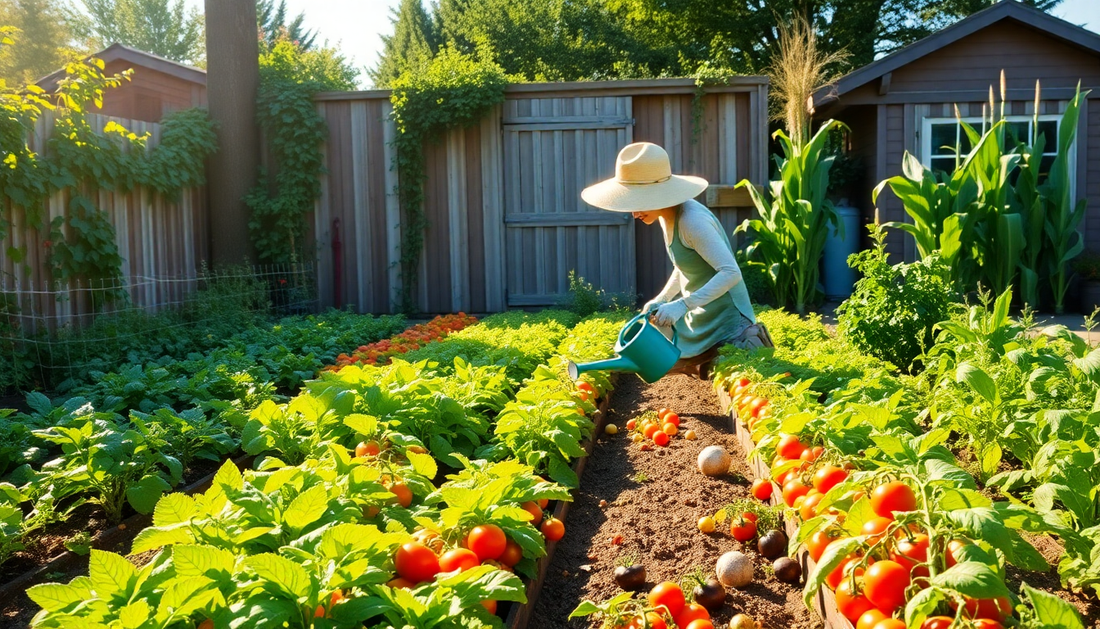
Cultivating Your Own Backyard Oasis: A Guide to Starting a Thriving Vegetable Garden
Share
In today's fast-paced world, where convenience often trumps connection, there's a growing desire to reconnect with the natural world and take control of our food sources. One of the most rewarding ways to do this is by starting a backyard vegetable garden. Whether you're a seasoned green thumb or a complete novice, this comprehensive guide will walk you through the steps to create a thriving oasis right in your own backyard.
Understanding the Basics of Backyard Gardening
Embarking on a backyard vegetable garden journey requires a solid understanding of the fundamentals. From selecting the right location to choosing the appropriate plants, every decision you make will impact the success of your garden. Let's dive into the key considerations to keep in mind.
Choosing the Perfect Spot
The first and most crucial step is selecting the ideal location for your garden. Seek out an area that receives at least six hours of direct sunlight per day, as most vegetables thrive in full sun. Consider the proximity to your home, as a conveniently located garden will make it easier to tend to your plants regularly. Ensure the soil is well-draining and free of any large rocks or debris that could hinder plant growth.
Preparing the Soil
Healthy soil is the foundation of a successful vegetable garden. Begin by testing your soil's pH levels and nutrient content. This information will guide you in amending the soil with the appropriate amendments, such as compost, manure, or lime, to create the optimal growing environment for your chosen plants.
Selecting the Right Plants
Choosing the right vegetables for your garden is crucial. Consider factors like your local climate, the amount of space you have, and your personal preferences. Popular options for backyard gardens include tomatoes, peppers, leafy greens, carrots, and zucchini. Be mindful of the mature size of each plant and plan your layout accordingly.
Implementing Efficient Watering Strategies
Proper watering is essential for the health and productivity of your vegetable garden. Establish a consistent watering routine, ensuring that your plants receive about an inch of water per week, either from rainfall or manual irrigation. Explore water-saving techniques, such as drip irrigation systems or mulching, to minimize waste and promote optimal moisture levels.
Designing Your Backyard Vegetable Garden
With the foundational elements in place, it's time to get creative and design your backyard vegetable garden. Embrace the opportunity to transform your outdoor space into a thriving, visually appealing oasis.
Raised Beds or In-Ground?
One of the first decisions to make is whether to opt for raised beds or an in-ground garden. Raised beds offer several advantages, such as improved drainage, easier access, and the ability to control the soil quality. However, in-ground gardens can be just as successful and may be more cost-effective for larger spaces.
Companion Planting and Crop Rotation
Companion planting and crop rotation are two powerful techniques that can enhance the productivity and health of your backyard garden. Companion planting involves strategically placing certain plants together to provide mutual benefits, such as pest control or nutrient sharing. Crop rotation, on the other hand, involves regularly shifting the location of your plants to prevent soil depletion and break pest and disease cycles.
Incorporating Vertical Elements
Maximize your available space by incorporating vertical elements into your garden design. Trellises, cages, or even simple stakes can support climbing vegetables like tomatoes, cucumbers, or pole beans, freeing up valuable ground space for other crops.
Aesthetic Considerations
While functionality is the primary goal, don't overlook the aesthetic potential of your backyard vegetable garden. Incorporate decorative elements, such as ornamental borders, whimsical pathways, or strategically placed garden art, to create a visually appealing and inviting space.
Maintaining a Thriving Backyard Vegetable Garden
Establishing a backyard vegetable garden is just the beginning. Ongoing maintenance and care are essential to ensure a bountiful harvest and a healthy, vibrant ecosystem.
Consistent Weeding and Mulching
Regularly removing weeds and applying a layer of organic mulch, such as wood chips or straw, will help suppress weed growth, retain soil moisture, and provide valuable nutrients as the mulch decomposes.
Pest and Disease Management
Vigilance is key when it comes to identifying and addressing pest and disease issues in your garden. Familiarize yourself with common garden pests and diseases, and develop a plan to address them using organic methods, such as introducing beneficial insects or applying natural pesticides.
Fertilizing and Amending the Soil
To maintain the fertility of your soil, incorporate organic fertilizers or compost into your garden on a regular basis. This will replenish the nutrients that your plants consume and ensure continued growth and productivity.
Harvesting and Preserving Your Bounty
As your plants begin to bear fruit, it's important to harvest them at the right time to maximize flavor and nutritional value. Explore various preservation techniques, such as canning, freezing, or dehydrating, to extend the life of your harvest and enjoy your homegrown produce year-round.
Embracing the Joys of Backyard Gardening
Starting and maintaining a backyard vegetable garden is a deeply rewarding experience that offers far more than just a bountiful harvest. It's a chance to connect with nature, reduce your carbon footprint, and cultivate a sense of self-sufficiency and accomplishment.
As you embark on this journey, embrace the challenges, celebrate the successes, and savor the simple pleasures of watching your garden thrive. With patience, dedication, and a touch of creativity, your backyard can become a verdant oasis that nourishes both your body and your soul.

